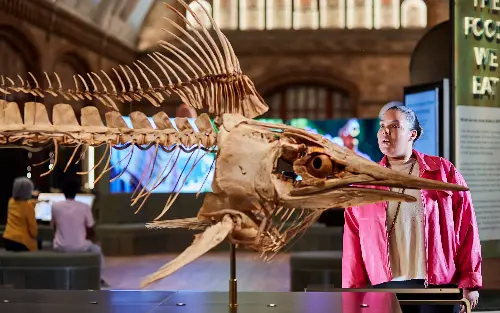
The opening infographic at the Natural History Museum’s new ‘Fixing Our Broken Planet’ gallery doesn’t mince its words: the cumulative effects of climate change — the declining condition of oceans and forests, and the number of species facing extinction — amount to “a planetary emergency” which requires a “global response”.
The one-roomed exhibition which follows this declaration of disaster is the museum’s first new permanent gallery since 2016. What begun in 2020 as a temporary display has grown into something more substantial: a collection of specimens nominated and introduced by the museum’s impressive team of research scientists. The exhibits — from microscopic fungi to a huge taxidermied bison — tell the story of mankind’s relationship with the planet through the food we eat, the materials we use, and the energy we harness.
Some of the specimens are bizarrely fascinating. If you’ve ever wondered whether whales have earwax (or even ears), then here is your answer: a white, triangular “wax plug” forms inside whales’ ear canals, with each new layer revealing the age of the whale — almost like the rings in a tree trunk. The interest isn’t purely biological, alas: as scientist Richard Sabin explains, these rings reveal what chemicals a whale is exposed to — including toxic pollutants and common pesticides.
Another scientist has chosen to display the huge range of plastic which can be found in the Thames. The wrinkled form of a Hula Hoops packet from 1986 or a crushed Ribena carton from the ‘90s are unusual exhibits to see framed on the wall of a museum, but they’re a tangible reminder that plastic takes decades or even centuries to decompose. Some animals have been creative in re-using plastic: it is often found in birds’ nests where, unfortunately, it runs the risk of strangling their young. Urban birds have also been known to use old cigarette butts to keep the nest free of ticks and fleas; innovation which, again, poses a danger to chicks.
From chemicals and materials, the exhibition moves to consider the relationship between the health of the planet and the health of humans. Some of the facts are hardly revelatory — continual light pollution is beneficial neither for humans nor nocturnal animals like bats and moths — but others are more surprising. From the 1930s to the 1960s, the most reliable pregnancy test involved injecting a South African clawed frog with urine.
There’s a possibility, with an exhibition like this, that it could be simultaneously preachy and doom-laden: a gallery of now-extinct species and sanctimonious messaging encouraging everyone to become a vegan. Despite its occasionally subdued approach — some exhibits, like new varieties of corn, are worthy but hardly eye-catching — and some token advice from young environmentalist “changemakers”, ‘Fixing Our Broken Planet’ manages to avoid both these charges.
This is not a gallery which leaves any visitors beaming with joy or with allayed eco-anxiety, but it still gives hope. There are scientists working to find solutions — from turning naturally-occurring granite into Lithium needed for batteries, to rewilding parts of Britain by re-introducing Bison into the countryside. This is an exhibition of expertise; a timely addition to the museum, which shows off the important research work which goes on behind the scenes.
Fixing Our Broken Planet opens April 3; nhm.ac.uk